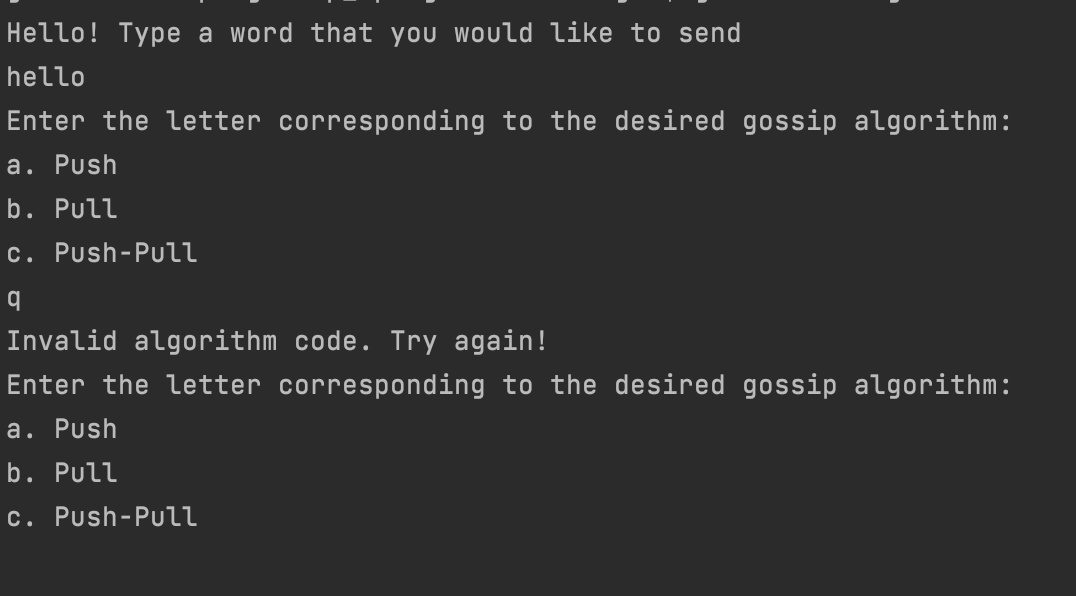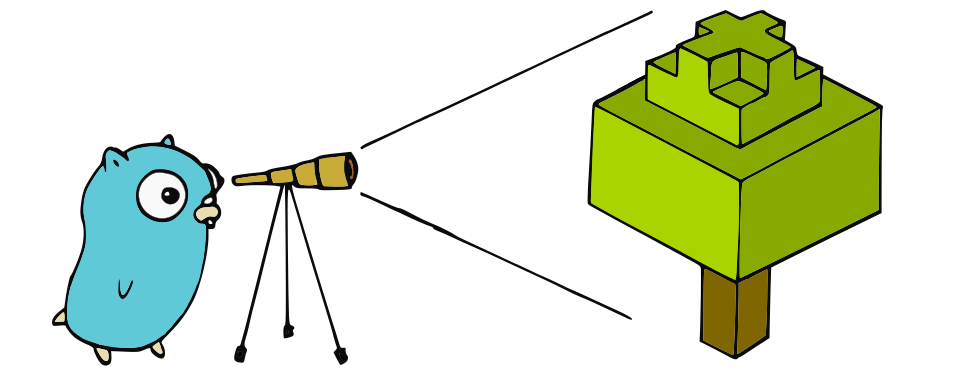Peerster design
Peerster refers to a gossip-based P2P system composed of multiple peers interacting with each other. A peer refers to an autonomous entity in the Peerster system. Note that we use the terms "peer", "node", "gossiper", and "participant" interchangeably, but they all refer to the same notion of "peer".
It features 4 specific features:
- P2P messaging
- Message Gossiping
- File sharing following the bittorrent algorithm
- Consensus on the file names using Paxos and Threshold Logical Clocks
Architecture
A peer is defined by a combination of interfaces, which will be added incrementally to augment the set of features throughout homeworks. We define a Peer interface in /peer/mod.go that is composed of multiple interfaces defined in the same folder. As homeworks progress, we augment the Peer interface with new additions.
The following stack diagram pictures the architecture of the system at the end of the course. This diagram provides the big picture of the system, which can help in understanding the expectations. However, it is not required, nor even expected, to understand it until the last homework. Furthermore, it only represents one of the possible architecture. Every implementation can use its own architecture, as long as it implements correctly the Peer interface.
┌──────┐ ┌───────────┬───────────┬───────────────────┐
│ │ │ │ │ │
│ │ │ │ │ P2P Data naming │
│ │ │ │ │ │
│ │ │ P2P text │ P2P data ├───────────────────┤
│ │ │ messaging │ sharing │ │
│ │ │ │ │ TLC + Blockchain │
│ Sto- │ │ │ │ │
│ rage │ │ │ ├───────────────────┤
│ │ │ │ │ │
│ │ │ │ │ Paxos │
│ │ │ │ │ │
│ │ ├───────────┴───────────┴───────────────────┤
│ │ │ │
│ │ │ Gossip protocol │
│ │ │ │
└──────┘ ├───────────────────────────────────────────┤
│ │
│ Network │
│ │
└───────────────────────────────────────────┘
Scope of the implementation
You won't be responsible for implementing all aspects of the peer. Your peer will be passed a peer.Configuration object containing some elements that you will be asked to use. For example, you won't be responsible for handling the messages serialization yourself. Instead, the peer is provided a registry.Registry object that you must use to process messages and marshal them. This is the same for the provided transport.Socket, which provides function to send/receive message. We talk more about those later.
File organization
Emoji points to locations of particular interest for students.
├─docs Documentation
|
├─gui
| ├─httpnode Wraps a peer with a REST API (handle a node with HTTP requests)
| └─web A Web front-end for an httpnode
|
├─internal Used for testing/debugging
|
├─peer
| ├─impl 👉👉👉 Where you will be working. Contains the peer implementation
| ├─tests All the tests
| mod.go 🔎 The peer interface
| *.go Definition of interfaces
|
├─registry
| ├─proxy Needed by the binnode for the integrations tests
| ├─standard Provided to the peer to handle messages
| mod.go The registry interface
|
├─transport Defines the mean to exchange messages between peers
| ├─channel A socket implementation based on channels
| ├─proxy A special socket needed by the binnode for the integration tests
| ├─udp 👉 Socket implementation, based on UDP
| mod.go 🔎 Contains the Socket interface and packet/message definitions
|
├─types Defines the types of messages exchanged between peers.
| *_def.go 🔎 Message types sent/received between peers
| registry.go The message registry
Networking
A peer is not responsible for managing its connection from/to the other peers. For that purpose, the peer receives a transport.Socket object as an input argument, which precisely serves that purpose.
The socket object is defined in /transport/mod.go. A peer uses it to receive and send data to/from other peers. The first job of HW0 is to provide a socket implementation based on UDP. There is a provided socket implementation using go channels in /transport/channel/. This implementation is used in some tests.
You'll remark that Send() and Recv() both have timeouts. Those timeouts can be used to periodically (for example every second) unblock send/recv operations in order to perform some checks. For example, in case the node is shutting down, the node should stop receiving messages.
Marshal/Unmarshal packets
A socket works with transport.Packet elements. However, only raw bytes can be sent over the network. This is why transport.Packet offers marshal/unmarshal functions that must be used to transform a packet to/from a []byte buffer:
pkt := transport.Packet{}
buf, err := pkt.Marshal()
if err != nil {...}
var newPkt transport.Packet
err = pkt.Unmarshal()
if err != nil {...}
Peer's address
A peer's address is defined by its socket, which is provided in the configuration the peer receives:
func NewPeer(conf peer.Configuration) peer.Peer {
...
myAddr := conf.Socket.GetAddress()
...
}
Note that when we refer the the peer's address, we actually mean the peer's socket address. For simplicity we most of the time don't add that extra precision. Using port 0 makes the system randomly choose a free port. 127.0.0.1:0 is extensively used in tests.
Data over the network
In order to support interoperability between implementations we provide the strict definition of data exchanged on the network. Each element sent/received on the network is defined as a transport.Packet element. It is the combination of a transport.Header and a transport.Message (see /transport/mod.go):
transport.Packet
┌─────────────────────┐
│ │
│ transport.Header │
│ ┌────────────────┐ │
│ │ │ │
│ └────────────────┘ │
│ │
│ transport.Message │
│ ┌────────────────┐ │
│ │ │ │
│ └────────────────┘ │
│ │
└─────────────────────┘
A transport.Message contains the marshaled representation of a types.Message (see /types/mod.go). Two representations are needed to support a message being sent on the network. types.Message (/types/mod.go) is the "rich" representation used by the peer internally, and transport.Message (/transport/mod.go) is used over the network.
To make the conversion from a transport.Message to its corresponding types.Message you must use a registry. See next section.
The following illustration shows what type of message each element of the system use:
Peer A Peer B
┌──────────────┐ Socket A Socket B ┌──────────────┐
│ │ ┌───────┐ ┌───────┐ │ │
│ │◄───────►│ │◄────►│ │◄───────►│ │
│ │ └───────┘ └───────┘ │ │
└──────────────┘ └──────────────┘
│ │ │ │ │ │
└────────────┴─────────────────┴──────────┴─────────────────┴────────────┘
types.Message transport.Packet []byte transport.Packet types.Message
--- ---
transport.Header transport.Header
transport.Message transport.Message
Message registry
When a transport.Packet is received, the transport.Message it contains needs to be unmarshalled from a buffer (the Payload: json.RawMessage) to an actual meaningful types.Message message (ie. transform a json.RawMessage payload to, for example, a types.ChatMessage). To ease this process, we provide a Registry, which automatically maps a packet (transport.Packet) to a callback that will be invoked when using a provided function on the registry. This registry is provided as input argument to a peer and is defined in /registry/mod.go.
When you create your gossiper, you must call RegisterMessageCallback for all types of different (types.Message) messages you can receive. Each homework will tell you the new messages to include. The Exec argument is a function that is part of your peer implementation. When you receive a packet from the socket, you must call ProcessPacket with the packet received, which will call the callback registered with RegisterMessageCallback for that message. Here is an example:
// The handler. This function will be called when a chat message is received.
func (m XXX) ExecChatMessage(msg types.Message, pkt transport.Packet) error {
// cast the message to its actual type. You assume it is the right type.
chatMsg, ok := msg.(*types.ChatMessage)
if !ok {
return xerrors.Errorf("wrong type: %T", msg)
}
// do your stuff here with chatMsg...
return nil
}
// The part where you register the handler. Must be done when you initialize
// your peer with every type of message expected.
conf.MessageRegistry.RegisterMessageCallback(types.ChatMessage{}, XXX.ExecChatMessage)
// The part where you call the handler. When you receive a message on the socket
// and want to process it on your peer, use the registry.
pkt, err := conf.Socket.Recv(time.Second * 1)
if err {...}
// if this is a chat message, calls ExecChatMessage()
conf.MessageRegistry.ProcessPacket(pkt)
When you need to do the opposite, ie. transform a types.Message to a transport.Message, you must use MarshalMessage() from the registry and pass a pointer to the types.Message message you want to marshal:
// I want to send a chat message to a peer.
msg := types.ChatMessage{...}
remotePeer := XXX
myAddr := conf.Socket.GetAddress()
transpMsg, err := conf.MessageRegistry.MarshalMessage(&msg)
if err != nil {...}
header := transport.NewHeader(
myAddr, // source
myAddr, // relay
neighbor, // destination
0, // TTL
)
pkt := transport.Packet{
Header: &header,
Msg: &transpMsg,
}
err = socket.Send(remotePeer, pkt)
if err != nil {...}
REST API
/gui/httpnode contains an http server that implements a REST API for a peer. It allows one to use the peer functionalities via HTTP requests. To start the http server there is a CLI in /gui/mod.go. To use this CLI, go to /gui/ and execute go run mod.go start -h to see the help.
CLI HTTP node REST API
┌────────┐ ┌────────┐ ┌─────────┐
│ │ wrap(peer) │ │ listen │ │
│ ├───────────►│ ├────────►│ │
└────────┘ └────────┘ └─────────┘
Binary node
/internal/binnode contains the implementation of a peer that uses an http binary (/gui/mod.go). The binnode starts an http node and wraps the peer functionalities with HTTP requests. This binary node is used in integration tests to mix the student's implementation with some reference implementations and check the interoperability.
Binnode CLI binary HTTP node
┌─────────┐ ┌─────────┐ ┌─────────┐
│ │ 1:call │ │ 2:start │ │
│ ├───────►│ ├────────►│ │
└────┬────┘ └─────────┘ └─────┬───┘
│ │
│ │
│ REST API │
│ 4:use ┌─────────┐ 3:listen │
└───────────►│ │◄───────────────┘
│ │
└─────────┘










